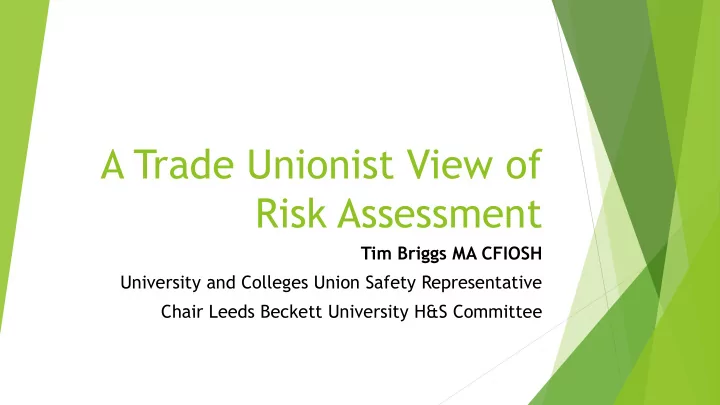

A Trade Unionist View of Risk Assessment Tim Briggs MA CFIOSH University and Colleges Union Safety Representative Chair Leeds Beckett University H&S Committee
My personal belief It is people that makes things unsafe It is people that makes things safe
Perceptions of Hazards In relation to hazards adults are considered responsible for their actions Are they always trustworthy or sufficiently well informed? After all it is only “Common Sense” ! 3
Changing Attitudes Work as Work as it imagined really is 4
Assumptions If we assume Assumption will make an Ass U Me 5
Naive Views are easily manipulated Where weak opinion exists people are at mercy of how information is presented Influence of the popular press Are journalists able to distinguish all manner of characteristics making the risk? 6
Learning The Lessons From The Past Great Fire of Silvertown – London – Buncefield Grenfell Tower Herald of Free Texas City Enterprise – Gulf of Mexico Costa Concordia (Macondo Oil Rig)
The Response To Risk Propensitity REWARDS to take risks Balancing Behaviour Percieved Accidents Danger 8
Degrees of danger Sensible Risk Assessment Why were conkers subject to ridicule? 9
Consequences of Risk - Factors Perceptions When was road traffic at its most dangerous – 1937 or 2017 Despite the huge increase of road traffic the risk of an accident has decreased by a factor of four Will this argument alter the response of a mother whose child has been killed in a road accident? Societal – will accept 10 deaths from 10 accidents will not accept 10 deaths from one accident Different groups will have different perceptions of 10 hazards
How big a part does culture play? The Health & Safety Mantra’s Health and Safety is part of the day job Health and Safety is not a bolt on extra Health and Safety is just plain common sense Managers manage Managing safety is just good management No blame culture Zero accidents Employees are our most important asset Etc, etc, etc---------- Mantra ‘ An expression or idea that is repeated, often without thinking about it, and closely associated with something’ Reality? 11
Safety Culture and Management Human beings are so innovative are they not? 12
Risk Assessment Contributes to Good Workplaces Why do we need good work and workplaces? is therapeutic; helps to promote recovery and rehabilitation; leads to better health outcomes; minimises the harmful physical, mental and social effects of long- term sickness absence; reduces the risk of long-term incapacity; promotes full participation in society, independence and human rights; reduces poverty; improves quality of life and well-being. Improves self esteem worth and value Source Woodall and Burton 2006 13 See notes view
Advantages Reduce damage to Becoming legally compliant equipment or goods Know what is to be managed Improves quality issues Reduces cost of illness absence Can help increase trust Increases learning in the Contributes to continuous organisation improvement Can aid better Protects corporate communication reputation Can hep to develop trust Can be prevention by Improve productivity being proactive Prevention of waste A process all areas of business can use
What seems to be the norm? No employee involvement Failing to review risk assessment Experts telling us what to do Failing to protect people Impractical controls not included in workforce implemented Does not take account of No systematic examination cognitive effects Over estimating – RA being reactive Underestimating risk RA process being tick box Out of date information used approach Risk Assessments used to justify Not considering decisions already taken technology advancements Does not encompass different Creates division levels of knowledge
Learning Lessons & Unseen Benefits “Someone Upstairs Cares Syndrome” Management Involvement Improved Communication Improved Trust & Respect The Hawthorne studies of the 1920s Improved Teamworking Elton Mayo Western Electric Hawthorne Works in Cicero, Illinois Gap filling (CI) Employee & Organisational learning Reduction of costs and efforts Improves productivity - profitability - lessens waste Protects Corporate and individual reputation Least of all legal compliance 16
Recommend
More recommend